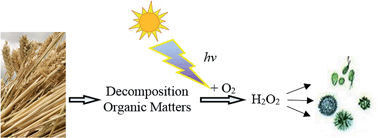Photochemical production of hydrogen peroxide from natural algicides: decomposition organic matter from straw†
Abstract
The ability of decomposition organic matter from three natural algicides (barley, rice, and wheat straw) and natural organic matter (NOM) isolates to generate hydrogen peroxide under simulated solar irradiation was evaluated in order to understand the mechanism of indirect algae inhibition through a photochemical pathway. Specific optical properties (higher phenolic hydroxyl group contents and lower E2/E3) of barley straw organic matter (BSOM) reveal its outstanding ability to produce H2O2 as a photosensitizer. The appearance of a protein-like structure in BSOM indicated that bacteria or fungi probably transformed the structure of BSOM and brought other organic matter, which may account for its distinct optical properties. The ΦH2O2 of BSOM obtained through aerobic decomposition is 14.73 × 10−5, which is three times the value of SRHA, whereas the ΦH2O2 value of BSOM obtained for non-aerobic decomposition was 5.30 × 10−5, still higher than that of SRHA. The ΦH2O2 of rice straw organic matter was slightly lower than those of SRHA and SRFA, but much higher than that of wheat straw organic matter. The superior ability of BSOM to generate H2O2 was partly responsible for the outstanding potential and prior choice of barley straw for cyanobacteria or algae inhibition in various plant decomposition products.


 Please wait while we load your content...
Please wait while we load your content...